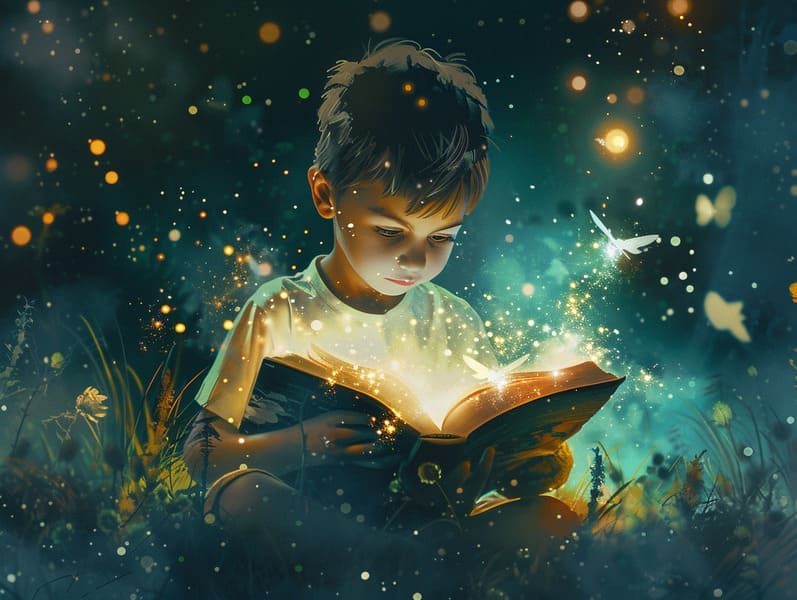
Timeless fairy tales have timeless appeal. These stories have been spoken from one generation to the next far before they were ever documented. They arose from a variety of civilizations, including European traditions. They were initially passed along among elders, often carrying themes and messages concerning the societal norms and beliefs of the time.
The renowned Brothers Grimm, Jacob and Wilhelm, were among the first to collect many of these beloved stories. Their volume, "Grimm's Fables," included classics like "The Little Glass Slipper," "Hansel and Grethel," and "Snow-White and Rose-Red," which have since become pillars in the world of iconic fairy tales. Similarly, Hans Christian Andersen's magical fairy tales, such as "The Mermaid," and "The Duckling that Could," have enchanted hearts worldwide, securing their place in the pantheon of timeless fairy tales.
Despite their ancient origins, these tales remain as relevant as ever, especially as bedtime stories for kids. These fantastical tales are now available in different formats, including artistically illustrated books, delightful animations, and digital fairy tales.
Their unwavering allure can be attributed to several magical reasons:
Important Morals: Traditional fairy tales often convey important moral lessons. Narratives like "The Wolf and the Liar" teach the value of sincerity, while "The Tale of the Tortoise and the Hare" show the values of resolve and humility. These narratives offer young readers clear distinctions between truth and falsehood, guiding their moral compass in a gentle yet profound way.
Compassion and Knowledge: Fairy tales frequently illustrate personalities facing problems and hurdles, stimulating listeners to resonate with their struggles and boost their triumphs. For instance, "The Story of Beauty and the Beast" demonstrates the virtue of valuing inner qualities to acknowledge the true nature of a character, nurturing warmth and awareness.
Cultural Recognition: Many ancient fairy tales are rooted in the cultural contexts from which they originated. Reading these stories can provide illuminating insights into different social structures, nurturing a sense of global appreciation and knowledge.
Fantasy and Imagination: The mythical elements in old fairy tales—magic wands—awaken children’s fantasy worlds. These fairy tales transport readers to extraordinary realms, stimulating imaginative ideas and a sense of marvel that lasts a lifetime.
Classic fairy tales are not only whimsical but also enlightening. They work as enchanted tools in enhancing various mind and heart abilities in the young. When timeless fairy tales are voiced, they improve speaking abilities by offering new words and complicated sentence structures. This practice also enhances hearing abilities and concentration, as young readers stay focused, ready to see what happens next.
Furthermore, examining the themes and characters of timeless fairy tales can enhance intellectual skills and critical thinking. Children are taught to find patterns, forecast, and grasp cause and effect. These analyses also benefit the young reveal their thoughts and feelings, adding to their emotional intelligence.
In today’s high-tech era, the accessibility of online fairy tales has made these stories more reachable than ever. Online platforms and digital apps extend large libraries of bedtime fairy tales that can be enjoyed or listened via anytime, anywhere. Fairy tales spoken are particularly favored, giving an fascinating method for young readers to take part in these whimsical stories. Audiobooks and read-aloud videos move characters and settings to life, often complemented by captivating music and soundtracks that intensify the narrative adventure.
The persistent attraction of classic fairy tales lies in their ability to shift to current eras while staying true to their core messages. Contemporary takes of these narratives often present more inclusive figures and modern settings, making them familiar to today’s audience. However, the underlying themes of heroism, kindness, and fair-mindedness remain unchanged, continuing to resonate with children of all ages.
Old fairy tales also offer a sense of security and closeness. They extend a neat narrative with a unmistakable beginning, middle, and end, often coming to a close with the resolution of conflicts and the triumph of goodness over badness. This reliability can be easing for young readers, imparting a sense of dependability in an dynamic world.
Traditional fairy tales continue to allure and educate new generations, maintaining their elegance and importance in modern society. As bedtime stories for kids, they furnish a perfect blend of captivation and insight, facilitating moral values, empathy, and creativity. these guys The accessibility of digital storybooks and the likability of fairy tales voiced guarantee that these traditional fairy tales remain obtainable to new generations.
By safeguarding and disseminating these stories, we continue to venerate the rich tapestry of mythology and cultural heritage. Whether you are viewing a vibrantly illustrated book, perusing a digital library, or listening to an audio story, the majesty of ancient fairy tales is always within reach. These narratives highlight of the timeless strength of narratives and its ability to bring us together across epochs and places.
No matter if you are delving into a vividly illustrated book, browsing a online collection, or playing an spoken story, the magic of traditional fairy tales is always within reach.
These stories point out of the perpetual impact of storytelling and its ability to bind us across generations and cultures, making a tie that fascinates and enlightens alike.